1995 American Cho Oyo Expedition
Click on the pictures for a bigger view...
Cho Oyo is a Himalayan peak on the Nepal-Tibet border, about 35 km
west
of Mt. Everest. It is 8,202m (26,903') high, making it the 6th highest
mountain in the world. The mountain was attempted in April and May of
1995 by a group of 21 climbers, including 19 Americans and two Nepalese
Sherpas. Though not as well known as many of the other high mountains,
Cho Oyo has an interesting history.
It is considered one of the two or three technically easiest of the
8,000m peaks.
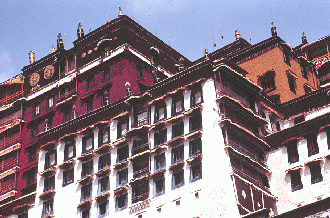 The
expedition approached Cho Oyo through China and Tibet. We spent
several days in Lhasa acclimatizing and seeing the sights. Lhasa is
dominated by the Portala Palace, formally the winter home of the Dali
Lama. With the Chinese occupation of Tibet, the Portala became largely
a museum, used to attract tourists and the dollars they bring. By the
time of our visit, a limited amount of religious activity had been
allowed to resume. Pilgrims visit the many temples, making offerings of
yak butter. Pervasive, however, are the Chinese security cameras,
installed it would appear as much to intimidate as to detect behavior
of
which they disapprove.
The
expedition approached Cho Oyo through China and Tibet. We spent
several days in Lhasa acclimatizing and seeing the sights. Lhasa is
dominated by the Portala Palace, formally the winter home of the Dali
Lama. With the Chinese occupation of Tibet, the Portala became largely
a museum, used to attract tourists and the dollars they bring. By the
time of our visit, a limited amount of religious activity had been
allowed to resume. Pilgrims visit the many temples, making offerings of
yak butter. Pervasive, however, are the Chinese security cameras,
installed it would appear as much to intimidate as to detect behavior
of
which they disapprove.
The status of Tibet as an occupied country is clear. Chinese
soldiers
are everywhere. The Chinese control all aspects of the economy. It
is, for example, quite hard to get a Tibetan meal anywhere in Tibet.
All of the restaurants catering to tourists (important in order to
maintain minimal standards of hygiene) serve only Chinese food, even in
the small villages far from the capitol. I vividly remember on
incident when I was in the Bakor -- the main square in Lhasa. I was
negotiating with a Tibetan woman attempting to shave $0.20 off the
price of some trinket she was trying to sell me. East-west haggling is
a form of entertainment in much of the third world, and we quickly
attracted a crowd. It took the Chinese police all of a minute or two
to notice the gathering and for five of them to break it up.
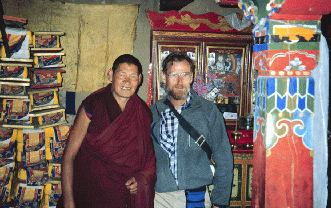 On our second day in Lhasa, three of us went for a hike in the
surrounding hills. We started at Sera, one of the four great
monasteries forming the core of the Gelugpa sect of Buddhists who ruled
Tibet for centuries before being ousted by the Chinese in the 1950's.
High above the Sera monastery at 4110m sits lies the small hermitage of
Sera Tse. Originally predating Sera itself, Sera Tse was destroyed
during the cultural revolution, in a superfluity of violence that saw
not only the razing of most of the temples and monasteries in Tibet,
but the killing of several millions of its people.
On our second day in Lhasa, three of us went for a hike in the
surrounding hills. We started at Sera, one of the four great
monasteries forming the core of the Gelugpa sect of Buddhists who ruled
Tibet for centuries before being ousted by the Chinese in the 1950's.
High above the Sera monastery at 4110m sits lies the small hermitage of
Sera Tse. Originally predating Sera itself, Sera Tse was destroyed
during the cultural revolution, in a superfluity of violence that saw
not only the razing of most of the temples and monasteries in Tibet,
but the killing of several millions of its people.
As we approached Sera Tse, we were met by one of the monks who has
been
working on its reconstruction. Tibetan tea was immediately offered and
could not be graciously refused. Tibetan tea is normally made with
tea, salt, and rancid yak butter. The good news for us was that the
hermitage must have been running low on yak butter, since our tea was
salted but otherwise clear. The bad news was that the tea was served
in cups that had not been cleaned since sometime prior to the birth of
the fifth Dali Lama.
Though not sharing a word in common, we had a long discussion with
the
monk. This ranged from information about the buildings at Sera Tse to
detailed comments on his part about the two Americans that had just
been captured by the Iraqis after wandering across the Kuwait border.
There was something a bit surreal in talking about current affairs with
a
monk in the middle of Tibet, kilometers from the nearest road.
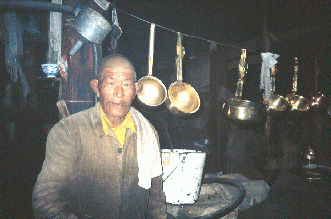 We reluctantly left our new friend at Sera Tse and headed for the caves
of Daadan, an important hermitage. We continued on to the Phabhongkha
temple, one of the oldest in the Lhasa valley. We noticed the kitchen
in full swing, with a huge pot of what could only be called
gruel boiling away on an open hearth stove. The cook stirring the brew
offered me a sample from a large wooden spoon. One of my great regrets
from the trip is that I declined, in an unwarranted fit of
bio-pathogenic
phobia.
We reluctantly left our new friend at Sera Tse and headed for the caves
of Daadan, an important hermitage. We continued on to the Phabhongkha
temple, one of the oldest in the Lhasa valley. We noticed the kitchen
in full swing, with a huge pot of what could only be called
gruel boiling away on an open hearth stove. The cook stirring the brew
offered me a sample from a large wooden spoon. One of my great regrets
from the trip is that I declined, in an unwarranted fit of
bio-pathogenic
phobia.
Two and a half days of truck travel from Lhasa and we were at the Cho
Oyo base camp, at an elevation of 4,875m. The drive traveled through
the driest and dustiest regions I could ever imagine. At base camp, the
wind blew constantly and the dust was so bad that we would sleep
wearing face masks or bandannas covering our nose. By way of
compensation, we had an unobstructed view of Cho Oyo 20Km distant and
still over 3km higher than we were.
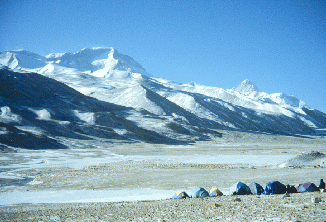
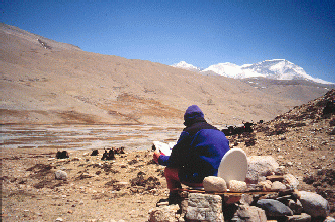
Among other features, base camp had a truly spectacular latrine.
Equipped with all the important luxuries (including a seat, but no
running
water) it was possible to sit comfortably doing your business while
contemplating the majesty of Cho Oyo and being contemplated in turn by
a herd of yaks.
The route from base camp to our advanced base camp (ABC) followed up
the
broad valley shown in the pictures above. Much of the way, we were on
the trail to the Nangpa La, an important trading route between Tibet
and Nepal that is also one of the principle routes used by refugees
escaping Tibet. Near the pass, our route swung left and climbed over a
series of moraines towards the base of Cho Oyo. The trail was 22km
long, with an elevation gain of almost 800m. Initially, we took two
days to cover the distance. Later in the expedition, we were able to
make the trip in one fairly long day.
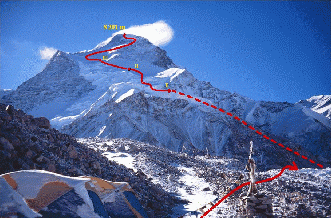 Advanced base camp, at an elevation of 5,660m, gave us our first
closeup
look at the mountain. We could see almost all of the remainder of the
route from the camp. Camp I was reached by walking 5 km over moraine
and rubble on top of active glacier, moving around behind a ridge, and
then slogging up a steep, loose scree slope to a camp site on the ice
cap perched on top of the ridge. Between Camps I and II was a series of
ice cliffs. Due to foreshortening, the distance between these two camps
was far more than it appeared from ABC. A relatively short plod over
moderate slopes lead to the site of Camp III. From there, the route
moved through a gap in the rock band protecting the upper slopes,
diagonaled over to an area of snow high on the mountain, and from the
top of this traveled about a kilometer across the summit plateau.
Advanced base camp, at an elevation of 5,660m, gave us our first
closeup
look at the mountain. We could see almost all of the remainder of the
route from the camp. Camp I was reached by walking 5 km over moraine
and rubble on top of active glacier, moving around behind a ridge, and
then slogging up a steep, loose scree slope to a camp site on the ice
cap perched on top of the ridge. Between Camps I and II was a series of
ice cliffs. Due to foreshortening, the distance between these two camps
was far more than it appeared from ABC. A relatively short plod over
moderate slopes lead to the site of Camp III. From there, the route
moved through a gap in the rock band protecting the upper slopes,
diagonaled over to an area of snow high on the mountain, and from the
top of this traveled about a kilometer across the summit plateau.
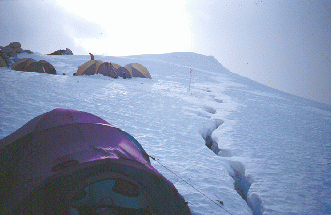 Camp I was situated at 6,400m (21,000'). The approach was entirely
over moraine and steep scree -- we wouldn't be climbing on snow until
above the camp. Until this trip, 6,400m was as high as I'd ever been.
Then, it was on top of a mountain in South America. Here, we were at
the same elevation but just starting to grapple with the climbing.
Camp I was situated at 6,400m (21,000'). The approach was entirely
over moraine and steep scree -- we wouldn't be climbing on snow until
above the camp. Until this trip, 6,400m was as high as I'd ever been.
Then, it was on top of a mountain in South America. Here, we were at
the same elevation but just starting to grapple with the climbing.
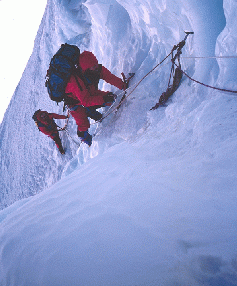
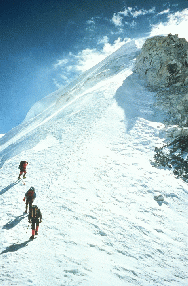 Above
Camp I, the route followed the crest of the Northwest ridge for
several hours. Not particularly steep, the going was nevertheless
exhausting due to the elevation. About a third of the way between
Camps I and II was a 70m section of ice cliff. Though we had a fixed rope in place, much of the route over
the cliff section was off balance and awkward. During the course of
the expedition, I wend up and down over the cliff twice. Both times
going up, it took at least an hour to cover the 70m and we were pretty
shattered at the top.
Above
Camp I, the route followed the crest of the Northwest ridge for
several hours. Not particularly steep, the going was nevertheless
exhausting due to the elevation. About a third of the way between
Camps I and II was a 70m section of ice cliff. Though we had a fixed rope in place, much of the route over
the cliff section was off balance and awkward. During the course of
the expedition, I wend up and down over the cliff twice. Both times
going up, it took at least an hour to cover the 70m and we were pretty
shattered at the top.
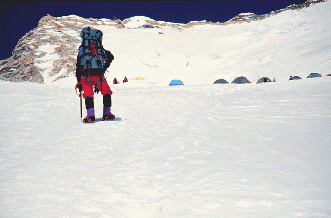
Beyond the ice cliff section was a series of gentle slopes and
sections
of ice angled at about 40-45 degrees. The last bit to Camp II was
quite moderate, but at the end of a long day it seemed to take
forever. On my first trip to Camp II, it took me half an hour to cover
the last 100m. Camp II was situated on a broad bench at 7,050m. On my
first trip there, it resembled a large village. We were set up with
three tents, while a large German expedition had maybe three times that
many. By my second trip to Camp II, the Germans were gone and we had
much more sense of being alone on a big mountain.
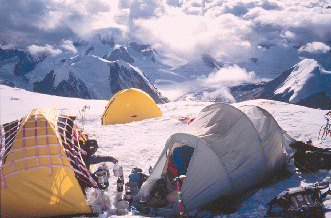
Camp III at 7,450m was approached up the moderate slopes just right
of
center in the picture above. This was a wild place. Behind us was the
summit pyramid, now very foreshortened and seemingly only a few hours
to
the top. Far, far below us was ABC, situated on the moraine at the
right-center in the photograph. We had oxygen
available to us, and used it in an attempt to sleep. Despite this, the
altitude, cramped space, and excitement kept me from any sleep at all.
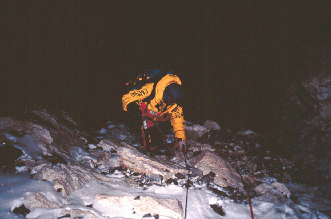 March 16, 1995. For the last week, a cloud cap had been forming around
the summit starting in the early afternoon. As a result, we got an
early start, leaving Camp III at 2:45am. Alpine starts are bad enough
at more reasonable altitudes. In addition cold, darkness, and shortness
of breath, I had to deal with other ``normal'' problems such as a
burned out headlamp bulb and the need to take a crap (a real challenge
in the dark and cold while wearing a one piece down suit). A half hour
or so out of camp, we reached the Yellow Band, a rock band separating
the snow from the moderate angle rock slabs above. The picture is of
Danuru Sherpa, following me up the fixed rope through a gap in the
Yellow Band. While most of the Sherpas that support climbing
expeditions are strong and experienced, Danuru is one of the few with
clearly superior climbing skills. He has been on the summit of Everest
twice and was the only member of our group to have previously visited
Cho Oyo.
March 16, 1995. For the last week, a cloud cap had been forming around
the summit starting in the early afternoon. As a result, we got an
early start, leaving Camp III at 2:45am. Alpine starts are bad enough
at more reasonable altitudes. In addition cold, darkness, and shortness
of breath, I had to deal with other ``normal'' problems such as a
burned out headlamp bulb and the need to take a crap (a real challenge
in the dark and cold while wearing a one piece down suit). A half hour
or so out of camp, we reached the Yellow Band, a rock band separating
the snow from the moderate angle rock slabs above. The picture is of
Danuru Sherpa, following me up the fixed rope through a gap in the
Yellow Band. While most of the Sherpas that support climbing
expeditions are strong and experienced, Danuru is one of the few with
clearly superior climbing skills. He has been on the summit of Everest
twice and was the only member of our group to have previously visited
Cho Oyo.
Both Danuru and Ang Fingo, our other climbing Sherpa, were from the
village of Phortse, just over the Nangpa La in Nepal. Due to the
vagrancies of international politics, however, instead of the one day
walk between Phortse and ABC, they had to travel many days in order to
make an ``official'' entry into Tibet. Fingo had been on something like
30 major climbing expeditions prior to ours without ever having been
included on a summit attempt. As a result, we put him on our first
summit team, letting him finally get to the top of an 8,000m peak. He
had an ear-to-ear grin when he got back to ABC! Now, a week later, it
was our turn...
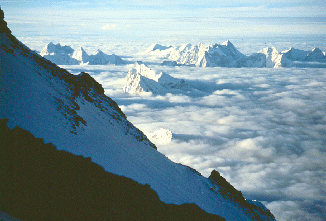 For the next several hours, we angled across the Northwest face of Cho
Oyo, headed for the snowfield leading onto the summit plateau. We had
watched previous summit teams moving horribly slowly through this
section, taking several breaths per step and suffering from the cold.
In my case, I was roped to Danuru and he seemed to want to get back to
Phortse in a real hurry. We moved along at a speed I didn't think was
possible but was sure would do me in in minutes. I was panting, the
air rasping in the oxygen mask, and worrying about how I was going to
keep from slipping on the snow covered rock, my balance hardly helped
by the 17 pounds of oxygen tank on my back. Because of the oxygen, our
excellent acclimatization, or the fact that I was too out of breath to
know better, we kept up the pace. In fact, we had to hold up at the
top of the snowfield for 10 minutes to make a scheduled radio call
before disappearing from radio contact as we crested onto the summit
plateau.
For the next several hours, we angled across the Northwest face of Cho
Oyo, headed for the snowfield leading onto the summit plateau. We had
watched previous summit teams moving horribly slowly through this
section, taking several breaths per step and suffering from the cold.
In my case, I was roped to Danuru and he seemed to want to get back to
Phortse in a real hurry. We moved along at a speed I didn't think was
possible but was sure would do me in in minutes. I was panting, the
air rasping in the oxygen mask, and worrying about how I was going to
keep from slipping on the snow covered rock, my balance hardly helped
by the 17 pounds of oxygen tank on my back. Because of the oxygen, our
excellent acclimatization, or the fact that I was too out of breath to
know better, we kept up the pace. In fact, we had to hold up at the
top of the snowfield for 10 minutes to make a scheduled radio call
before disappearing from radio contact as we crested onto the summit
plateau.
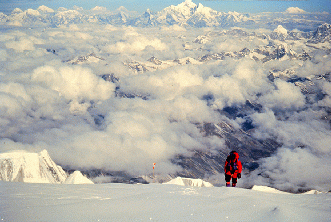 Once on the summit plateau, the angle eased off and we were in the sun.
The view was stupendous. We could see down into the foothills, and
beyond that, the great extent of the Tibetan plateau. Directly behind
us was Shishapangma, another 8,000m peak and the only such mountain
entirely within Tibet.
Once on the summit plateau, the angle eased off and we were in the sun.
The view was stupendous. We could see down into the foothills, and
beyond that, the great extent of the Tibetan plateau. Directly behind
us was Shishapangma, another 8,000m peak and the only such mountain
entirely within Tibet.
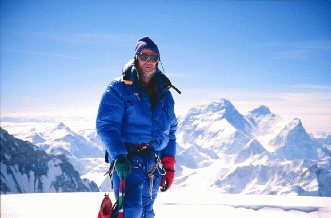 By 8:30am we were on top. As we reached the actual high point, we were
able to see Mt. Everest for the first time. (Everest is visible on the
right in the photograph, only 650m higher
than where we were standing.) There was no wind -- the air was
absolutely still. The temperature was warm, and in fact became
uncomfortably hot as we descended. After reading about all of the
epics with truly frightening weather that seem to accompany most climbs
to this elevation, it is clear just how fortunate and lucky we were.
All in all, a completely glorious summit day!
Ultimately, we put a total of fifteen climbers on top in four separate
summit teams over an eight day period.
By 8:30am we were on top. As we reached the actual high point, we were
able to see Mt. Everest for the first time. (Everest is visible on the
right in the photograph, only 650m higher
than where we were standing.) There was no wind -- the air was
absolutely still. The temperature was warm, and in fact became
uncomfortably hot as we descended. After reading about all of the
epics with truly frightening weather that seem to accompany most climbs
to this elevation, it is clear just how fortunate and lucky we were.
All in all, a completely glorious summit day!
Ultimately, we put a total of fifteen climbers on top in four separate
summit teams over an eight day period.
 The
expedition approached Cho Oyo through China and Tibet. We spent
several days in Lhasa acclimatizing and seeing the sights. Lhasa is
dominated by the Portala Palace, formally the winter home of the Dali
Lama. With the Chinese occupation of Tibet, the Portala became largely
a museum, used to attract tourists and the dollars they bring. By the
time of our visit, a limited amount of religious activity had been
allowed to resume. Pilgrims visit the many temples, making offerings of
yak butter. Pervasive, however, are the Chinese security cameras,
installed it would appear as much to intimidate as to detect behavior
of
which they disapprove.
The
expedition approached Cho Oyo through China and Tibet. We spent
several days in Lhasa acclimatizing and seeing the sights. Lhasa is
dominated by the Portala Palace, formally the winter home of the Dali
Lama. With the Chinese occupation of Tibet, the Portala became largely
a museum, used to attract tourists and the dollars they bring. By the
time of our visit, a limited amount of religious activity had been
allowed to resume. Pilgrims visit the many temples, making offerings of
yak butter. Pervasive, however, are the Chinese security cameras,
installed it would appear as much to intimidate as to detect behavior
of
which they disapprove.













